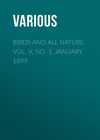Kitabı oku: «Birds and all Nature, Vol. V, No. 1, January 1899», sayfa 3
The giant East Indian honey-bee, which is probably identical with the giant of the Philippines, is the largest known species of the genus. They are about one-third larger than our common bee and build huge combs of very pure wax which are attached to overhanging ledges of rock or to the limbs of large trees. These combs are often five or six feet in length, three or four feet in width and from one and one-half to six inches in thickness. The amount of honey that they gather in the course of a season is enormous and it has been suggested that if introduced into this country they might be of immense value as they would doubtless visit mainly the plants which our honey-bees could not well gather from, such as red-clover, and thus increase the amount of clover seed as well as the quantity of honey already produced. Up to date, however, it is not proven that they will live in hives or that they can live at all in this climate; the latter being regarded as extremely doubtful by some of our best informed bee-men.
Not the least interesting thing in an apiary is the honey extractor, consisting of a large can inside of which a light metal basket is made to revolve by means of a simple gearing. The frames containing the full comb are placed in this basket, the caps being shaved off. After several rapid revolutions the comb is found to be empty and is then returned to the hives to be refilled by the bees.
The queen bee is about one-third larger than the worker and is the mother and monarch of the hive. Queens are sometimes raised by bee-keepers for sale, especially by those who have an improved strain of a certain species, or a new and desirable species of bee. When the bee-keeper gets a mail order for a queen he procures a mailing-cage, which is a small box-like cage covered with wire screen and cloth, in one end of which he places a supply of food, the other end being occupied by a ventilator. The queen and from eight to twelve workers, as royal attendants, are then placed in the cage, the wire-screen and cloth covers carefully wrapped around them, the address written, a one cent stamp affixed and her royal highness is ready for her trip across a continent, or, with additional postage, around the world.
When, from any cause, the bee-pastures become unproductive bees from different hives often declare war on their neighbors, the strong colonies singling out as enemies those that are weak or disorganized by the loss of a queen. The war is always pursued without quarter and thousands on each side perish in the fray, the victors always carrying off every drop of honey in the hive of the vanquished, leaving the unfortunate survivors of the defeated hive to perish by starvation.
In many parts of England when a member of the family dies someone must tell the bees; this is done by taking the house door-key and rapping thrice on each hive, repeating at the same time the name of the deceased and his station in the family. If this ceremony is omitted the bees will surely die. In some places the hives are draped with a strip of black cloth when a death occurs in the family and with white cloth in case of a wedding. If these ceremonies are omitted the bees are insulted and will leave. Singing a psalm in front of a hive that is not doing well will also set all things right, in some parts of England. I will not attempt to explain how the American bee-keeper rears bees without these ceremonies, but refer the reader to the various hand-books on bee-keeping which will doubtless explain it.
The bees occupy a position in the economy of nature far higher than that of mere honey-gatherers. The service they render in pollenizing the flowers is worth far more to the world than endless stores of honey. There are a number of flowers that are so adjusted that their pollen cannot of itself reach the stigma but is so disposed that it is certain to be carried away by any bee or moth that chances to visit it, while the stigma is so placed that an incoming bee is certain to reach it on first alighting on the flower and dust it with the pollen which has accumulated on the hairs on the under portion of the bee, or has clung to his legs; this, of course, causes cross-fertilization, a peculiar and wonderful provision of nature, which seems to be necessary for the preservation of fruits and flowers and for the improvement of the different kinds. Whole volumes have been written on this subject, which even now is not entirely understood, but a single case will give a little insight into the matter. The common primrose will produce even from seeds selected from the same pod, two different kinds of flowers, in about equal proportions, which are sterile of themselves. But each kind may, by means of the good offices of the bee or other honey-loving insect, fertilize the other. If no bees or other insects visit either of these flowers no seed can be produced and the life of the plant ends in a single season. Cross-fertilization is necessary to some plants and beneficial to all. Nature has so devised it and has accordingly made the flowers conspicuous to insects by painting them, in most cases, a different and brighter hue than the foliage of the plant, making the blossom, in some cases, give forth a pleasant odor, and in nearly all cases causing the flower to secrete the nectar which the insects love. Flowers which do not attract the insects by their bright colors, odor, or nectar, are generally adapted to cross-fertilization by the wind or are partly or wholly fertile in themselves.
It is a pretty well established fact that the flowers which we particularly esteem, the bright-colored, perfumed, nectar-producing varieties, owe their existence to the bees. We also owe the fruits which we love to the selection of the bee to a large extent. Some of the best varieties of strawberries are entirely sterile and must be planted in close proximity to fertilizing varieties in order to bring forth any fruit at all. Some varieties of pears also require fertilization by the bees, and cannot bear fruit if bees are excluded. Even the apple is not perfect unless fertilized by the bees, five distinct pollenizations being required to perfect a single blossom, and in places where orchards do not bear it is often found that the introduction of four or five hives of bees for each one hundred trees will cause them to bring forth fruit in abundance.
So, whether we wear bright flowers, or eat fruit or honey, or stroll through meadows sweet with clover, the handiwork of the bee follows us and impresses us with the fact that our little friend lives only to give us sustenance, sweetness, and pleasure.
BIRDS AS SHEPHERDS
IN Venezuela there is a species of crane, called by the natives the Yak-a-Mik, which is easily tamed and trained to look after a flock of sheep or take care of the inmates of the poultry yard. When these are placed in charge of this bird it may be implicitly trusted to take them to their feeding places in the morning and bring them safely home at night, not forgetting to hunt for and collect any stragglers. The Yak-a-Mik displays all the traits of character usually associated with the faithful sheep-dog. It can be amusing, too, for, while its usual gait is slow and sedate, it can execute the most fantastic waltzes and strike all sorts of absurd attitudes. A German agriculturist, Herr von Seyffert, had one of these cranes which took charge of a herd of heifers, driving them to and from their pastures. It also kept order in the poultry yard, stopping all fighting and disorder.
THE MISTLETOE
WILLIAM K. HIGLEY
FROM very early times plants, animals, and even minerals have played an important part in the expression of religious ideas and in the execution of religious rites. Among the plants, sacred, and closely allied to the mystic life of a portion of the human race, there is none more interesting and rich in legend than the mistletoe. This was associated with religious observances before the time of Christ and was mentioned by our earliest historians.
There are over seventy species of this peculiar plant. Both the American variety (Phoradendron flavescens) and the European, or true mistletoe (Viscum album), belong to a family of parasites, so called because they derive their nourishment entirely or in part from some other plant instead of taking it directly from the soil. Owing to the presence of the green coloring matter (Chlorophyll), in the stems and leaves, the mistletoe is not entirely parasitic, but is to a certain extent self-supporting, drawing but a portion of its nourishment from the tree on which it grows.
It is found both on deciduous and on evergreen trees. In some locations in Europe it is especially abundant on the apple tree and, if in the right climate, there are few tree species which are exempt from serving as its host.
The mistletoe is an evergreen shrubby plant of slow growth, attaining a length of about four feet and its duration of life is practically that of the tree on which it grows. The leathery leaves and rugged stems are yellowish green in color and, in the axils of the leaves, are the small and insignificant flowers, which ripen about Christmas-tide into pearly white translucent berries. The seeds are probably distributed through the agency of fruit-eating birds which, after eating, wipe their beaks on the trunks and limbs of trees, leaving the seeds snugly planted in the crevices of the bark.
In Scandinavian mythology we find the mistletoe used to cause the death of one of the favorite gods of the Norsemen, Baldur, the god typifying the beautiful, the good, and the wise. In this myth other friendly gods, fearing Baldur's death, with his mother, exacted an oath from animals, plants and minerals that they would not injure him. Unfortunately, however, the mistletoe was forgotten and Loki, the god of evil, knowing this fact and jealous of Baldur's beauty, gathered a branch, and taking it to Hödur, the blind god of brute strength, directed him how to aim it. Baldur was pierced by the mistletoe and fell to the ground, dead.
But it was in "Merrie England" that the mistletoe was held most sacred, most revered. The Druids, the early priests of the Gauls and Britons, were accustomed to retreat to the oak groves for their mystic rites. The mistletoe was not often found upon the oak, but when discovered, was the occasion of special rejoicing and peculiar ceremonies, being cut with a golden hook, and white bulls were sacrificed under the favored tree. We are told by some authorities that as the oak was the symbol of God, the All-powerful, so the mistletoe became the symbol of man, receiving his life and sustenance from God. There are other interesting myths; and, in fact, the mistletoe is closely woven with many beliefs and rites of the Druids.
At Christmas-tide the mistletoe is largely used for decorative purposes, especially in England, where the custom is ancient, and also in our own land, where each holiday season finds more and more of this unique plant gracing chandelier and window, until we, too, may some day find our maids all kissed —
"Under the mistletoe bough."
THE EAGLE
Bird of the broad and sweeping wing,
Thy home is high in heaven,
Where wide the storms their banners fling,
And the tempest clouds are driven.
– Percival.
THE bald eagle became the bird of our nation in the year 1873. It is at home in all parts of North America. Its nest in the top of a lofty tree is a common landmark in Maine, and on the great mountain peaks of the western states the nest is usually placed upon the rock where no man nor beast is able to climb.
The American eagle lives in America only, but an eagle living in the Old World looks very much like it. The American bird is larger than the one found in Europe. It is believed that the bird of our country sometimes visits Europe, for an eagle is seen there at times that seems to be our own bald eagle.
The birds that have beaks and claws like those of the eagle are very much like the cat family upon the ground. They are all fierce hunters and live upon weaker animals and birds. The greatest of all the cat family is the lion, the king of beasts. The greatest of the cats of the air is the eagle, and he is called the king of birds.
As the cats have claws and teeth for catching and tearing their prey so the eagles have beaks and talons which are strong and sharp. The cats come quickly upon their prey without the least noise. So do the eagles. They come down from the sky like lightning and nothing is swift enough to get away, unless it is warned of the eagle's coming.
An eagle sometimes lives to be over one hundred years old. Many years ago it was said that an eagle never dies of sickness nor of old age, but that its beak grows out of shape in its last years so that it cannot eat.
All people have admired the eagle. The Indians of America have always liked to wear the feathers of the king of birds, and in Scotland the chief was known by the feather of an eagle which he wore in his bonnet.
It often happens that a young eagle looks much larger than its father or mother. This is because the first feathers of the wings and tail are longer than the ones that grow in their place when the young eagle has once shed them. The young eagle is also darker than the old one. This is why some people have made mistakes in writing about them without knowing a young eagle from an old one.
Eagles of the same kind are not always of the same color. Some are darker than others and the markings are not alike. Some young eagles shed their downy feathers early and wear the dress of grown-up birds. Others keep some or all of their baby feathers five or six years. And there are some very old eagles still wearing some of the downy feathers of their first dresses.
Eagles kept in cages lose some of their fierce ways and change the colors of their dress. But they do not forget that they are eagles. A large cat once went under the bars of an eagle's cage to get the meat which had not been eaten by the bird. Down came the eagle, tore the cat to pieces, and ate him in a hurry.
The bald eagle is very fond of fish. I have seen him on a bright day sailing high above a lake where I was fishing. He was so slow and lazy that I did not think he was fishing too. But when he saw a fine large fish near the top of the water he came down like a flash, struck his claws into the fish, and flew away to his mate in a tree upon the land.
Sometimes the eagle gets the fish hawk to do the work for him. Waiting on the branch of some tree upon the shore he sees the fish hawk flying about over the water looking for his prey. As soon as a fish has been caught and the hawk is coming ashore to eat it, the eagle frightens the hawk so as to make him drop his fish. Then the eagle catches it again before it strikes the water.
It is because he is such a robber that some of the people of America did not like to have him chosen to be the bird of our nation. They felt that we ought to have a bird that is good towards all the other birds.
A poor family once lived for a long time by robbing an eagle. The father climbed to the nest and took away the meat which the eagle brought for its young. Every day he got food for his family from the eagle. When the young birds were almost ready to fly he cut the feathers from their wings so they could not leave the nest. Then he tied them in to make sure of his own meat every day. The young ones cried harder when tied and the old ones thought they were hungry and brought them more flesh.
When the young are old enough to fly the old eagles fly above them as if to show them how easily it is done. If the young do not try to fly when the old ones think it time, they are pushed out of the nest as if to kill them. But the young wings flutter so that the bird does not fall hard, and the old bird flies under her young one to prevent any harm.
The eye of this bird is so keen that it can see a small animal much farther than the animal can see the great bird. When out of sight in the sky the eagle can see a hare as it comes out of its hole. It comes down so fast that it sometimes catches the hare before it can get back to a safe place.
When the sky is clear the eagle flies very high, but on cloudy days he keeps nearer the ground. He likes to fly over waterfalls because fish are to be caught as they pass over the falls. At Niagara Falls eagles are often seen because animals are sometimes carried over the falls by the rushing water, and the birds can get them easily.
The eagle likes to face the sun and fly towards it as if he thought he could reach it. For a long time people wondered how he could face the sun so without being made blind. But we know now that he has a covering for his eyes that keeps them from all harm from the strong light. If you watch a chicken you may see it has two eyelids for each eye. So has the eagle. The eagle has a sort of eyebrow of feathers that may help protect his eyes from the strong light.
While the eagle is graceful in flying he is not at all so in walking. Few birds are so awkward on their feet. His great claws are made for catching his prey rather than for walking. He can tear things with them and use them in fighting, but he has not much use for them upon the ground.
When they cannot get the food that suits them best eagles will sometimes steal farm animals. Lambs, or even full-grown sheep are easily carried away. They have been known to attack children and carry them off. But they do not often do this, and they have been known to carry them a little way and then set them down again as if the load were too great or they did not wish to eat them.
A story is told of a man who lived a long time ago, and who had but one child, a little girl. He wished to adopt a poor little baby boy, but his wife did not wish to take care of the boy. He had the baby carried to the top of a tree in which was the nest of an eagle. The baby was placed in the nest so he could not fall, and the man and his wife walked under the tree. The child cried so that the lady heard him. She supposed it had been carried there by the bird. Great haste was made to get the baby down, and the lady was so pleased to think she had saved the child from being eaten by the birds that she kept the little one as her own son.
Eagles hunt in pairs. One flies about near the ground to scare the game from the bushes and trees, while the other keeps watch from above to swoop down on the first thing that comes in sight. While their young ones are in the nest the old birds are very active. They are fierce if anyone comes near the young.
Sometimes they show as much cunning in taking their prey as any of the cat family. In flying down to catch animals upon the ground they take care to fly so that their shadow will not frighten their prey. An eagle has been known to destroy an animal too large to be picked up by flying at the animal fiercely as it stood upon the edge of a steep place. The wings of the bird frightened the animal so as to drive it over the cliff to meet death upon the rocks below.
(Continued on page 36.)










